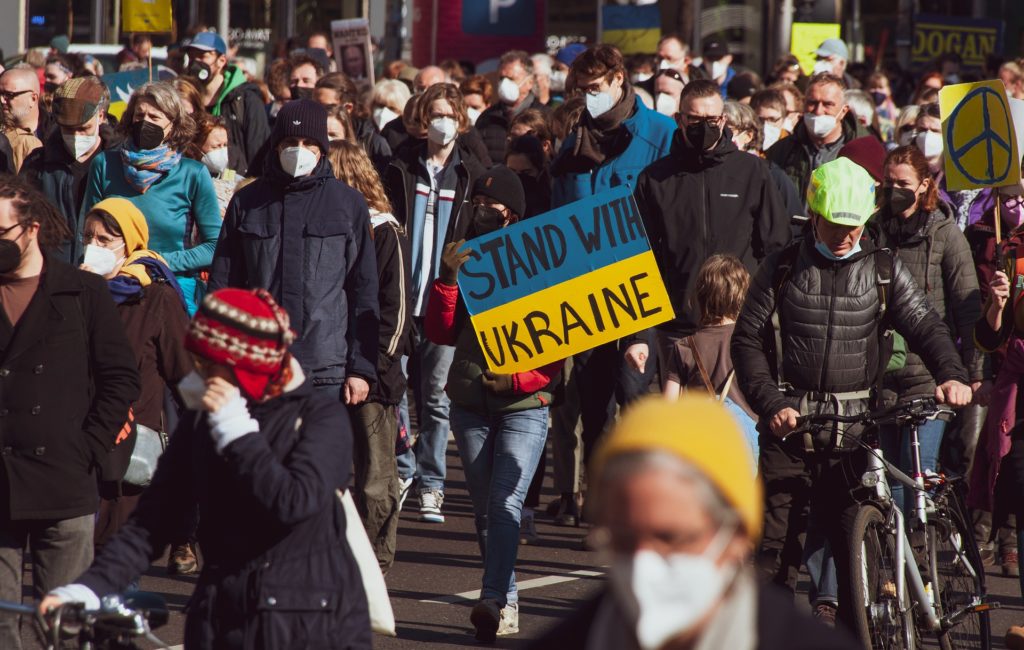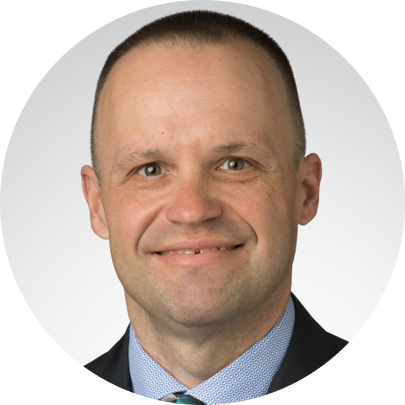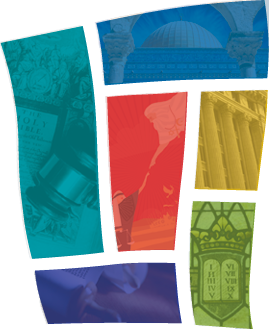
Ukrainian Autocephaly: A Challenge to Russian Neo-Imperialism
Nicholas Denysenko
This article is part of our “Russia/Ukraine: Law and Religion Perspectives” series.
If you’d like to check out other articles in this series, click here.
President Vladimir Putin of the Russian Federation has cited several issues motivating his invasion of Ukraine. These include the encroachment of NATO upon Russia, Ukraine as an indivisible part of a multinational Russia, the threats posed by “decadent” European values, violations of the rights of Russophones in Ukraine, the threat of a crackdown on the Russian Orthodox Church in Ukraine (ROCU), and the prevalence of neo-Nazis in the Ukrainian government. Patriarch Kirill, leader of the Russian Orthodox Church-Moscow Patriarchate (ROC-MP), has recently voiced his support of Putin’s claims in a series of statements and sermons. Kirill blamed external enemies for trying to separate Ukraine from the unity of nations of Russia, Ukraine, and Belarus. He also justified the war on the basis of Putin’s unsubstantiated claim that Ukraine has committed genocide in Donbas, and the government’s hosting of gay parades in that region.
The public remarks of Putin and Kirill represent an ideological intersection that defines a multinational space with one ruler, one church, based in Moscow. The ideological concept is known as the Russkii Mir, or “Russian World”, and represents a neo-imperial project that fuses Putin’s geopolitical aspirations with the ROC-MP’s attempt to become the leader of the world’s Orthodox Churches. The Russkii Mir concept identifies contemporary Russia, Ukraine, and Belarus as core nations whose unity persists in the spiritual and political realms. The three nations are a reconstitution of the mythical union of the city-states of medieval Kyivan Rus’, and their co-existence in the ROC-MP seals the unity of the people of these nations.
Ukraine’s ongoing pursuit of a democratic republic associated with Europe, and the creation of an autocephalous Orthodox Church in 2018-19, posed a formidable challenge to Russia’s Russkii Mir project and manifested Ukraine’s national and spiritual independence from Moscow. In this essay, I will show how Ukraine’s struggle to establish an autocephalous Church contributed to Russia’s recent bloody invasion.

Background: the Ukrainian Autocephalous Movement in the Revolutionary and Soviet Periods
When the Romanov monarchy collapsed in 1917, Ukrainians began to consider their future. Public figures and politicians debated whether to create a sovereign nation-state or join a post-monarchical federation centered in Russia. Church leaders immediately took action to restore native traditions that had been muted during the long period of subordination to the Russian Church.
The ROC, also on the path of reform, was able to restore the patriarchate of Moscow. Leaders of the Ukrainian Church set the stage for autocephaly by receiving a blessing from the new Patriarch Tikhon of Moscow to convoke an All-Ukrainian council that would determine the path of the Ukrainian Church.
Taking place in 1918, this council, along with certain events surrounding it, illuminated the growing tension between Ukrainian and Russian cohorts. Russian leaders of the Church in Ukraine belittled the Ukrainian language and referred to those seeking autocephaly as followers of Ivan Mazepa, the eighteenth-century hetman of the Zaporizhian Cossacks who fought with Sweden against Tsar Peter I. The Russian imperial regime arranged for Mazepa’s anathematization, a tactic that aimed to delegitimize him and those who would follow his path in succeeding generations. The All-Ukrainian council of 1918 decided to remain in the ROC and refused to adopt Ukrainian as its liturgical language. Supporters of Ukrainian autocephaly angrily accused the Russian leaders of the council of violating the rules, since the presidium unilaterally removed several dozen pro-autocephaly delegates to ensure that the Ukrainian Church would remain subordinate to the ROC-MP.
The outcome of the 1918 council proved a pivotal event in widening the fissure separating independent-minded Ukrainians from Russians. The primary cohort of Ukrainian clergy and lay intellectuals turned to subversion when they convened a council in October 1921 and created their own episcopate, a new Ukrainian Autocephalous Orthodox Church (1921 UAOC). The 1921 UAOC was controversial because no bishops participated in the council, which led other Orthodox Churches to deny their legitimacy because of the presumed absence of apostolic succession. Initially, the Bolshevik regime tolerated the 1921 UAOC in its strategy of conquering by fomenting division. The Bolsheviks hardened their position on the 1921 UAOC after it began to grow, and eventually forced the church into liquidation by 1930.
Despite the liquidation of the 1921 UAOC, the spirit of Ukrainian Church independence remained alive among Ukrainians both in the Soviet Union and in Poland.
Despite the liquidation of the 1921 UAOC, the spirit of Ukrainian Church independence remained alive among Ukrainians both in the Soviet Union and in Poland. The church independence movement resumed in German-occupied Ukraine in 1941-2, especially among Ukrainians who had been in Poland. When Stalin revived the ROC-MP in 1943 to galvanize popular support in the war, the ROC-MP bishops castigated the leaders of the autocephalous and Greek Catholic Churches, who refused to subordinate themselves to the ROC-MP, accusing them of colluding with the Nazis. After the western portions of Ukraine previously under Poland were subsumed in the Soviet Union in the 1945 Yalta agreement, Stalin moved immediately to fuse the Ukrainian Greek-Catholic Church (UGCC) into the ROC-MP by coercion.
The official Church literature published in the Cold War decades is revealing. The ROC-MP authorized the publication of a Ukrainian-language version of its periodical Pravoslavny’ Visnyk. Many of the essays express the unity of the peoples of Russia, Ukraine, and Belarus and credit the Soviet Union for reuniting Ukraine with Russia, and for defeating their enemies – Nazis and purveyors of Catholic proselytism. The polemical religious literature from this period fused Ukrainian religious groups that sought independence with fascism and Catholic proselytism. In other words, Orthodoxy became the only legitimate religious option for a united front of Russians, Ukrainians, and Belarussians. Furthermore, the promulgation of this narrative amounted to the carrying out of informational warfare, with the Soviet state circulating its message through a Church periodical.
This religious narrative continued until the end of the Soviet period, therefore coinciding with the 1,000th anniversary of the Baptism of Rus’ in 1988. Gorbachev’s policies of glasnost and perestroika enabled the legalization of the two previously exiled Church groups – the UGCC and the UAOC. Both returned to Ukraine in 1989, and by the end of 1990, the groups had reclaimed many parishes in West Ukraine, upending the hegemony of the ROC-MP. The leader of the ROCU in Ukraine, Metropolitan Filaret, continued to espouse the anti-Western, Russkii Mir ideology until Ukrainian independence made it possible for his own church to seek autocephaly. He orchestrated a unified appeal for autocephaly from the episcopate of the ROCU to the patriarchal synod of the ROC-MP in 1992.
However, the ROC-MP not only rejected the petition, but accused Filaret of fomenting schism. The ROC-MP deposed Filaret in 1992 and anathematized him in 1997. In this way, Filaret joined the ranks of his predecessors excommunicated by the ROC. Despite this personal attack, Filaret pursued the path of autocephaly relentlessly as the leader of the Kyivan Patriarchate (KP) from 1995-2018.
Post-Soviet Ukraine: Revolutions, the Russkii Mir, and Foreign Intervention
In 1992, three Orthodox Churches existed in Ukraine. The ROCU was the largest, followed by the KP and the UAOC. Signs of political exploitation of the Church began to surface in the elections of 2004 when leaders of the ROCU openly supported Victor Yanukovich as the only “Orthodox” candidate.
In the early years of his presidency, Victor Yushchenko recognized the Church’s influence in the public sphere, and he attempted to mitigate political exploitation of the Church by uniting the three Orthodox Churches and petitioning for their autocephaly from the ecumenical Patriarchate of Constantinople (EP). The EP’s patronage of a united Ukrainian Church would both legitimize it and liberate it from manipulation by Russian soft power. Yushchenko’s unification attempt failed when Filaret – then patriarch of the KP – would not agree to the conditions.
The situation continued to evolve during Yanukovich’s presidency in 2011-12 with the illness of Metropolitan Volodymyr, leader of the ROCU. A cohort of bishops attempted to remove Volodymyr from his position, reduce the autonomy of the ROCU by revising its statute, and seize authority by taking his seal. These efforts failed initially, and Metropolitan Volodymyr attempted to sustain the unity of the ROCU.
In July 2013, the ROC-MP observed the 1,025th anniversary of the Baptism of Rus’ through a stational celebration that took place in Moscow, Kyiv, and Minsk. Church dignitaries participated in the celebration by traveling on a patriarchal train. The celebrations in each city included speeches by the respective presidents (Putin, Yanukovich, and Lukashenko) on the unity of the three nations. President Putin held an audience with Patriarch Kirill and the episcopate of the ROCU in Kyiv and bestowed national awards to some of the bishops.
This celebration can be said to have been a public ritual expression of the Russkii Mir, an alliance of politicians and Church leaders. The two nominally autocephalous Orthodox Churches – the UAOC and KP – were neither invited nor did they participate. The stational celebration of the 1,025th anniversary of the Baptism of Rus’ was designed to circulate the narrative of the indivisible unity of the three nations in the public sphere, for all to behold – a key tactic of the informational campaign of the Russian federation and ROC-MP. As the initiators of the campaign, the leaders of the Russian state and Church used soft power to accomplish their objective.
The Euromaidan Revolution of Dignity in 2013-14 was a point of no return for Ukraine’s relationship with Russia.
The Euromaidan Revolution of Dignity in 2013-14 was a point of no return for Ukraine’s relationship with Russia. Ukraine demonstrated its desire to become part of Europe by refusing to change its course despite Russia’s annexation of Crimea and support of separatists in Donbas. Putin’s invasion of Crimea and war in Donbas elicited strong responses from Ukrainian Church leaders. In his role as the interim leader of the ROCU, Metropolitan Onufry called upon Patriarch Kirill to intervene with Putin to withdraw Russia’s forces. Patriarch Filaret (KP) went further in his response by casting Putin as a murderer and referring to him as the “New Cain” in an encyclical letter. These defiant responses from 2014 are notable because they show that even the ROCU defied Russian aggression.
After Metropolitan Volodymyr of the ROCU died, Metropolitan Onufry succeeded him as the leader of the ROCU in the summer of 2014, just as the new president Petro Poroshenko was rallying Ukrainian support for the war in Donbas. At this time, Vadym Novinsky, an oligarch from St. Petersburg who received Ukrainian citizenship from Yanukovich, became the patron of the ROCU and the most outspoken critic of the Ukrainian Church’s struggle for autocephaly.
The informational warfare intensified exponentially in the midst of this crisis. Continuing to use soft power, the Putin regime and ROC-MP blamed all violence and bloodshed on the UGCC and KP, aligning the leaders and their faithful with radical nationalism and schism. The ROCU asserted the legitimacy of their Church over the UAOC and KP by constantly referring to their canonicity as the only Ukrainian Orthodox Church recognized by other Orthodox Churches in the world. This tactic was possible only by comparing themselves with Church leaders like Filaret, whose illegitimacy in the Church was caused by the ROC-MP’s anathema in 1997.
It is crucial to emphasize the effectiveness of soft power through the informational campaign. The Ukrainian Parliament requested autocephaly of ecumenical Patriarch Bartholomew during the Orthodox council of Crete in 2016. The appeal referred to liberating Ukraine from Russian colonialism, but many participants in the council of Crete were unconvinced because they believed that Filaret and the Ukrainian Churches outside of the ROC-MP were indeed illegitimate.
Poroshenko resumed Yushchenko’s stalled project of attempting to unite the Orthodox Churches and securing autocephaly from the EP. Where his predecessors failed, Poroshenko finally succeeded, as the EP signaled their readiness to unite the Churches and grant autocephaly.
The events of 2018-19 marked the first turning point for the Ukrainian Orthodox Churches. First, the EP saw the entire process through despite fierce opposition from the Russian state and ROC-MP. Patriarch Kirill and his entourage attempted to dissuade the EP during a meeting in Istanbul on August 31, 2018. Patriarch Kirill repeated the refrain of the Russian state that it was Americans who orchestrated the Maidan and that the vast majority of Ukrainians supported the ROC-MP. In reality, however, the EP had secured multiple signatures of Ukrainians bishops and had both the support of the president and a majority of the Ukrainian Parliament.
For the first time in modern history, an Orthodox Church leader rejected the Russian meta-narrative on Ukrainians, oversaw the creation of a unified Church (Orthodox Church of Ukraine, or OCU), and granted it autocephaly, effectively liberating Ukrainians from Russian subordination. It is safe to say that the EP was tired of the ROC-MP’s subversion of the EP’s activities – especially when the ROC-MP withdrew from the long-planned council of Crete in 2016 and questioned its legitimacy. The EP’s willingness to select the narrative of Orthodox Ukrainians who wanted autocephaly over the Russkii Mir ideology was of greater significance. To put it simply, they let the Ukrainians tell their own story, and they were able to deflect the soft power of the Russian campaign.
The vast majority of the ROCU did not join the new OCU. Together with the ROC-MP, the ROCU broadened the informational campaign and attacked the EP, claiming that the EP had itself become schismatic by associating with the KP and UAOC. The informational campaign described the EP as unionist, in reference to the union forged at the council of Florence-Ferrara in 1438-39. The EP adhered to this union for ten years, while the ROC rejected it immediately. Nevertheless, the EP’s historical connection to union with Catholics was convenient for the informational campaign. The ROC-MP now claimed that the EP had joined the forces of the West seeking to separate Ukraine from Moscow and weaken Russia. At this point, Russian leaders began to hint at a transition from soft power to hard power. Ominous threats to protect faithful of the ROCU and Russophones uttered by Dmitry Peskov, Sergey Lavrov, and Putin previewed the present Russian invasion of Ukraine.
Presently, the leaders of the UGCC, OCU, and EP have condemned Putin’s invasion of Ukraine. Many church leaders have also expressed outrage at Patriarch Kirill’s justification of the war. One church, however, stands at the crossroads – the ROCU. Many bishops of the ROCU have condemned Putin and expressed protest by refusing to commemorate Patriarch Kirill at the Liturgy. Some eparchies have requested the convocation of a council to establish complete autocephaly. The leaders of the ROCU continue to commemorate Kirill during the liturgy and do not respond to requests for a council that would decide to separate from the ROC-MP. Whether or not the war precipitates the final separation of Orthodox Ukrainians from Russian subordination is not yet clear.
The grievances presented by Putin and Patriarch Kirill originated with the initial attempts of Ukrainians to establish their own republic and autocephalous Church in the revolutionary period. In each succeeding historical stage, the Ukrainian struggle for political and ecclesial independence has led to informational warfare on the part of Moscow. From the revolution until today, Russian state and Church leaders have used soft power in an information campaign assigning all Church and political leaders that sought independence to a unsavory cohort of radical nationalists, fascists, neo-Nazis, and schismatics. The view is purely binary: evil politicians and Church leaders aligned with the West, as opposed to those morally upright people who represent the medieval unity of Kyivan Rus’ and belong to the “right” Church in the ROC-MP. The truth is that this story is about a struggle to establish a modern nation-state following the collapse of two empires, and an attempt to become an autocephalous Church subordinate to no one but God. The story, then, is a tale about Ukrainians whose fight for independence challenged the Russian attempt to rebuild an empire, whose refusal to submit was anchored in a fight for freedom, whose defiance ultimately inspired Putin to complete his transition from soft power to hard power, unleashing a bloody invasion of Ukraine. ♦

Nicholas Denysenko is Emil and Elfriede Jochum Professor and Chair and professor of Theology at Valparaiso University in Indiana. The author of many books and articles on liturgy and religion in Ukraine, he is also an ordained deacon of the Orthodox Church.
Recommended Citation
Denysenko, Nicholas. “Ukrainian Autocephaly: A Challenge to Russian Neo-Imperialism.” Canopy Forum, April 17, 2022. https://canopyforum.org/2022/04/17/ukrainian-autocephaly-a-challenge-to-russian-neo-imperialism.

